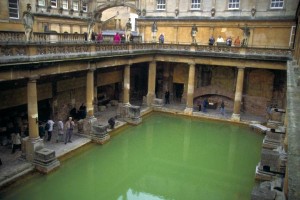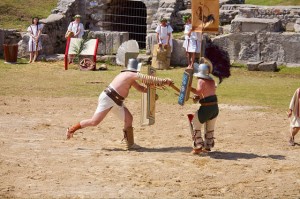How Roman Baths Were Heated
The Romans were expert builders; they knew that in order to make their cities thrive they must provide an excellent water system. Therefore great importance was placed on drainage, public fountains and baths. Roman baths were built not only in cities, but also in houses and even in forts. The baths were heated in one of two ways.
The favoured method was natural hot springs, with thermae (bath houses) built around them. When the baths were supplied with water from rivers or aqueducts, however, it was heated by a fire before it passed through pipes to the bathing area. Both men and women could use the baths, but the females had to be separated from the males and used an adjoining complex that housed a smaller thermae. The bathing fees for women were much steeper than those required of men.
The bath building was entered through a passage that led into the room lined with seats and clothes pegs. This room, also known as the ‘apodyterium’, is where people undressed. Sometimes the visitors were accompanied by servants and slaves who helped them disrobe. The apodyterium was sometimes watched by an attendant. It’s unlikely the Romans bathed naked; they were more likely to have worn a light covering known as the ‘subligaculum’ and sandals with thick soles to protect their feet from the heated floors.
 Visitors to a Roman bath could enjoy three types of bath: the hot pool was known as the ‘caldarium’, the ‘tepidarium’ was kept at an intermediate temperature and the ‘frigidarium’ was used as a cold plunge pool. The building also had an atrium, which was employed as an exercise yard. The bath houses were equipped with large public latrines which consisted of marble seats placed over open channels, through which there was a constant flow of water.
Visitors to a Roman bath could enjoy three types of bath: the hot pool was known as the ‘caldarium’, the ‘tepidarium’ was kept at an intermediate temperature and the ‘frigidarium’ was used as a cold plunge pool. The building also had an atrium, which was employed as an exercise yard. The bath houses were equipped with large public latrines which consisted of marble seats placed over open channels, through which there was a constant flow of water.
Roman baths were frequented by the upper classes, who wished to network and conduct business affairs. While they bathed they were offered refreshments, and at an extra price the visitors could take massages.
The treatments were undertaken by slaves known as ‘aliptae’. The baths were also used for cultural purposes – they had libraries, eating areas and rooms that were used for public speaking.
Facts about Roman recreation
 Cleanliness – The Romans were renowned for their personal hygiene. An emperor was once asked why he took a bath every day. He answered: “because I do not have the time to bath twice.”
Cleanliness – The Romans were renowned for their personal hygiene. An emperor was once asked why he took a bath every day. He answered: “because I do not have the time to bath twice.”
Bathing and politics – The baths were often used in advantageous ways by the Romans. If a politician wanted the favour of the public, he would offer free admission for the day.
Cleaning agents – The Romans did not use soap within their washing routine. Instead, they employed oils to cleanse the body and then used sticks called ‘strigils’ to scrape the skin.
Healing waters – The Romans believed that the waters they bathed in had special healing properties. They bathed to relieve rheumatism, arthritis and even hangovers.
Fragrant oils – The Romans were particularly fond of massage oils and perfumes. They treasured unguents made from such ingredients as almonds, bergamot and myrtle.

